THE WHITE MAPLE LEAF Author Raffaella Cortese de Bosis
THE WHITE MAPLE LEAF
THE STORY OF
PRIVATE THOMAS BRADE HOPE
Canadian Army
(Scotland, June 3 1915 – Italy, December 13 1944)
Author
Raffaella Cortese de Bosis
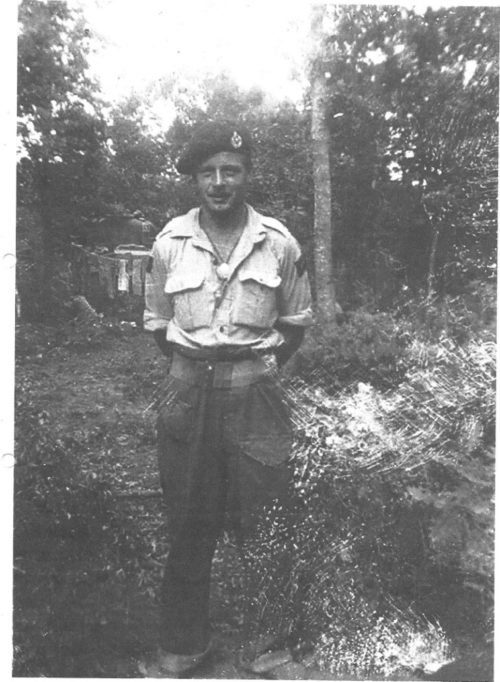
A blanket of multi-coloured leaves stretches as far as eye can see, a giant mosaic whose minuscule tiles cover every inch of the land. The silence of the woods is broken only by the dull sound of falling branches. A boy wipes sweat and sawdust off his face and finally sits on a small log that he just cut. For him it is like a trophy: he is 14, has rudimentary tools and is alone.
The sun is setting on this part of the Scottish inland. “Time to go home” one would say. But Tommy Hope does not have a home any longer. His mother Christina died in 1922 and his father James just two years later. Tommy is the sixth of ten children. He was born in Biggar, Scotland June 3, 1915.
Therefore, the kids are sent to Quarrier’s Orphan Homes of Scotland in Bridge of Weir. It is an orphanage that was founded by William Quarrier, a shoemaker who became a successful merchant. He purchased land on which he built the homes in 1876. At the beginning, there were two cottages and a bigger building that served as school and church. In later years, the structure grew to include over 40 houses.
Tommy spends 6 years here also attending school, but when he turns 14 he decides to quit and find work. He will regret this decision. He is strong, with a higher than average IQ, full of energy, not afraid of hard work. His only fear is that of confined spaces. He is a quiet boy but is gifted with a sense of humor, which will always support him. He works in the fields, learns to drive the tractor and the truck: he is so proud of himself. Engines and mechanics will eventually become a hobby for him, together with the passion for fishing and football, playing forward.
In early 1930, Tommy is only 15 but life has already thrown tough hardships at him. He reacts, his inner resources help him find a way to resurface. His grey eyes are always looking for the silver lining. It is the eve of yet another abandonment: he will be sent to Canada by the Quarrier’s Orphan Home. This is part of a program that the Orphanage started back in 1872 and ended in the 1930s. With this program the total number of kids who emigrated from Quarrier’s to Canada is over 7000.
The evening of March 27, 1930 is the last one he spends in this facility. The night is darker than any other one he can remember. He has no idea what is in store for him, he will have to take a ship and sail for many days, alone…and Canada, where is it? and more importantly: why? The howling of the wind blowing across the Scottish countryside blends with the screeching sound of his nightmares. At dawn, the journey begins. Together with other kids and personnel from the Quarrier’s they reach Glasgow by bus. For most of them the city is a place they never have seen. Some stare at the buildings, others sit still with lowered eyes, glued to their seats, others talk loudly.
Waiting for this small group of young passengers is Letitia. But she is not a loving female figure, ready to encourage them with warm hugs: she is a giant of the sea, the vessel that will take them away from Scotland perhaps forever. They get off the bus and become part of a crowd, in line to reach the main gate. The kids have each a wooden trunk with their few clothes and heaps of hope. They board the ship and reach the deck. They are so high above the water!
The giant of the sea slowly sails off. The sea envelops the kids’ memories like a liquid shell. If their memories are not secured, soon their identity will only be a name on their certificates.
Tommy spends time by himself, tries to imagine what his future will be like: when you are 15 years old the future is very long.
After a week, the journey is almost over. But stormy clouds loom. The turbulent waves of the Atlantic rise and attack every part of the hull: at night it is as if huge sea monsters were forcefully slamming against the vessel. The noise is thundering and unbearable. Some kids are hardy enough to withstand the conditions, others are so seasick they can neither stand nor lie down; eating is out of the question and so is sleeping. When the rage of the elements finally loses its intensity, the shores of Canada are close. The sense of relief is tangible among the kids. Once disembarked, someone clearly heard the Captain saying he thought he was not going to make it.
April 6, 1930. Halifax. Tommy sets foot on Canadian soil. The kids are granted the status of immigrants. At this point they are taken to the Fairknowe Home in Brockville, Ontario, the “distributing home”, as it was called. Another journey, many hundreds of miles, by train, on the Canadian National Railway. It is bitter cold, their clothes are not warm enough, snow is still on the ground.
As they reach Brockville, they stand before a large, white mansion on First Avenue, not far from the Saint Lawrence river.
The story goes that many of the boys endured hardships and abuses, they were treated as slaves and humiliated by the farmer families to whom they were entrusted. But it also seems that others were better off and had a happier destiny.
Tommy Hope says goodbye to William, Archibald, Robert, Hugh, who had sailed on the Letitia. Again, he faces the unknown. He is assigned to farms in the Beckwith area, then in Toronto. For five long years he works as a woodcutter. His hands are raw, his skin is peeling, covered with snow. Breaks are shorter and shorter, with temperatures falling way below freezing it is risky to sit still.
In the midst of this frozen environment, Tommy grows. He is appreciated for his work. He is reliable and indefatigable. He has many friends. At the end of one winter, he crosses the path of the Coleman family. A family of cattle breeders and farmers in the Beckwith Township. One day, Tom knocks on their door and is welcomed warmly. The Colemans become Tom’s family, his home. With them, he finds the warmth that he had never known. He works with Elisha Coleman, the head of the family. He shears sheep, cuts wood and tends the vegetable garden. Tom becomes passionate with maple syrup production. That was inevitable!
He thinks back to Hugh Blair, who boarded the same liner. After he died, Hugh’s daughter Peg Blair, Director of Computer Operations for Canada Immigration (ret.), found a notebook he had beside his favorite chair. He wrote about life at Quarriers and his trepidation upon embarking for Canada, about the Salvation Army band playing “God be with you till we meet again.” His was not a horror story. He ended up with a very kind family who took him in virtually as one of their own and he had a very positive experience. He truly believed that coming to Canada was the best thing that happened to him.
To William Cameron, who was sent to Kingston where he was treated as a slave for seven years, often made to sleep in the barn. One day, exhausted by the hardships, he walked away, until one farmer invited him to come to his house. This changed his life: the neighbor found him a job at the Belleville cemetery and then he went to work at the Ontario Hydro.
To Robert Robertson, who served with the Stormont, Dundas and Glengarry Highlanders during WWII. He worked at Phillips Plant until shortly before he died in 1969. His daughter Melanie Robertson King is a well known professional writer. She published a number of fiction and non-fiction books and is deeply dedicated to the research about Home Children.
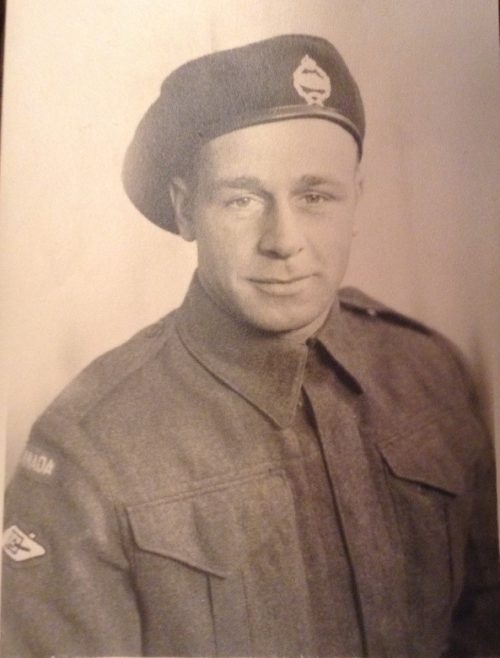
Pvt T. B. Hope
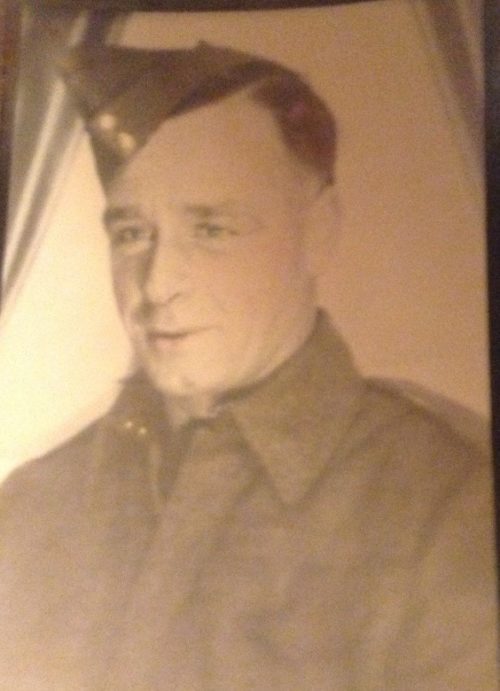
Pvt. T. B. Hope
In 1942 Tommy decides to enlist as the war rages in Europe. His Canadian family remembers that in his heart, enlisting meant that he could see his brothers again.
That same year, on October 21, he joins the Canadian Army in Toronto and after a period in Canada, on May 14, 1943, he leaves for the UK to join the 2nd Armoured Regiment. In this period, he does manage to see a few brothers again, by traveling to Scotland.
And here, the desire to take his little sister Anna to Canada at the end of the war grows.
He writes home and talks about his assignment to Africa and then to Italy, where he arrives on November 13, 1943 with the 48th Highlanders. His service number is B134707.
He is a good soldier. He was awarded the Canadian Volunteer Service Medal with Clasp, the 1939-45 Star, the Italy Star, the Defense Medal, and the War Medal.
He describes the horror he felt in seeing the sheer destruction: Cassino wiped to the ground, the villages inland destroyed, but with the natives welcoming them with great warmth and thanking them for the sacrifices and the help. Crossing the Melfa River, between May 24 and 25 was a massacre. The German reaction was full of wrath. The number of casualties is astronomical. It is here that Major John Mahoney, Westminster Regiment, Canadian Army (Canadian Infantry Corps), was awarded the Victoria Cross for his outstanding valour.
This is around Pofi, in the province of Frosinone, a little over one hundred kilometers from Rome. Pofi is a medieval town, perched on a hill. For a few days, it is the backdrop to the Strathcona Horse Regiment.
June 3, 1944 is an exciting day for Tommy: he turns 29. During the war, celebrations are more in the spirit than with food and gifts, but here it’s an exception: he will get his present today, and it is a most unexpected gift. Lance Corp. Robert S. H. Greene (after the war will become an Anglican priest) is part of the crew of a tank and he had shared a few operations with Tommy. At his side, Greene notices that Tommy has a phobia of enclosed spaces. Just imagine how he would feel inside a tank. Greene tries to have him transferred to another unit. He is successful and when he tells him, Tommy cannot believe it. He feels free and elated. To him, it is way more than a present! He lies on a hammock, enjoying the quiet of nature.
War is still long, danger lurking everywhere. The Lanark and Renfrew Scottish pushes north. The hot summer gives way to an incessant rain: the unpaved roads that had been treaded by the Canadians suddenly turn into impassable muddy streaks. The rivulets become tumultuous torrents. This helps the enemy.
In early December 1944, his unit is involved in Mezzano to clean up the east bank of the Lamone River. Fog and rain are unrelenting and operations are even more extenuating that normal. Mud is everywhere. In the night between December 10 and 11, they cross the Lamone River. The unit is able to establish a bridgehead. The number of casualties is very high.
Tommy writes home: “thank you for your prayers, they are helping me very much.” He also mentions his fiancée and regrets not having married her and that when he comes back to Canada he will be an old man …
In the midst of this horror, a present arrives from his family, for Christmas, which is just a few days away. Tommy writes home immediately, to thank them and send them the Christmas wishes. Despite the raging war, the letter does make it into the hands of his family.
Now, Canale Naviglio is the objective of the Canadians. The attack starts during the night of December 12. Along the banks, the counterattacks are fierce and cause the unit to divide in isolated groups. The enemy fire prevents the reserves from reaching the Canal. Even worse, low visibility does not allow air support. That night only, there were 21 deaths. From the houses requisitioned by the Germans, a rain of projectiles blocks the Lanark and Renfrew. They resist for two long days, all muddy and exhausted. 38 died.
December 13, 1944 is close. It is the shortest day of the year. Tommy’s last day on this earth.
The battle’s fury is unstoppable. An incandescent monster rips the blanket of multicolor leaves. Its destructive force burns and riddles them out. When it stops raging, the curtain of dust that it had created abates. Silence returns. The leaves disappear under the debris.
All except one: it is of glistening white stone and is carved on the tombstone of Tommy B Hope in the Canadian War cemetery in Villanova di Bagnacavallo.
Mary Campbell, Tommy’s sister receives a letter stating that Tom had been killed instantly by a bullet and was resting in the cemetery. He was well liked and had many friends. In another letter she reads that he “was killed while helping to carry through one of the most brilliant and courageous actions of this war. His devotion to Duty and dependability made him a valuable man and we miss him. And they laid him away among his other fallen comrades and we erected a cross in his memory.” Major General A. E. Walford, Department of Defence, writes to Elisha Coleman. He informs him that Thomas B Hope gave his life in the service of his Country and pays tribute to the sacrifice he so bravely made. The Colemans are heartbroken over the death and will always have fond memories of him. Layer after layer, history follows its course. Time brings us to today. After over 75 years, Tommy’s natural family and the Coleman’s are finally able to share their memories. I reached out to Neilson Hope, son of Tommy’s youngest brother George and Brenda Ferrier, granddaughter of Elisha Coleman, permitting the building of this utterly unexpected relationship.
Neilson: I was so pleased to hear from her; she was very friendly. I have always wanted to go to Canada and see where he was sent. Finally I know where to go!
Brenda: “It is certainly an amazing circle completed. I guess I figured that with my dad and all those who knew Tommy being gone it was the end of his story. I was very surprised when you let me know you had been in touch with family in Scotland. I hope to remain in contact with Neil and learn more about Tommy’s family. Thanks for your hard work and dedication so others can learn more about Tommy and the lives of our brave Canadian soldiers.”
For the first time ever, on June 3 2020, the Wartime Friends Association and the Coleman and Hope families, thousands of miles one from the other and without having ever met personally, paid homage to the memory of Tommy on his birth day. (in the pictures, the flowers laid on the grave in Bagnacavallo and those brought by the Coleman family to the Beckwith Memorial Park Cenotaph.
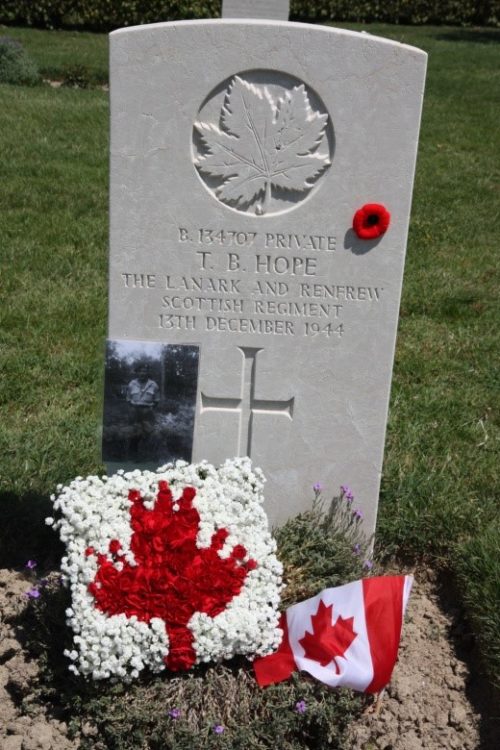
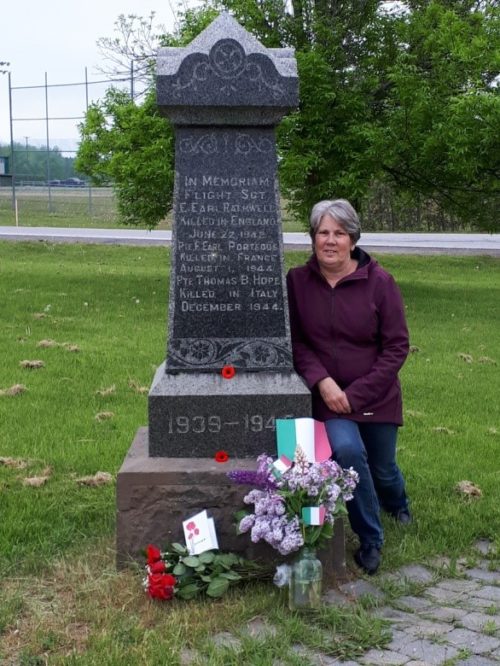
Thank you, Tommy. God bless. Grateful to the Hope and Coleman families for the precious information and photos. Please visit www.wartimefriends.org
